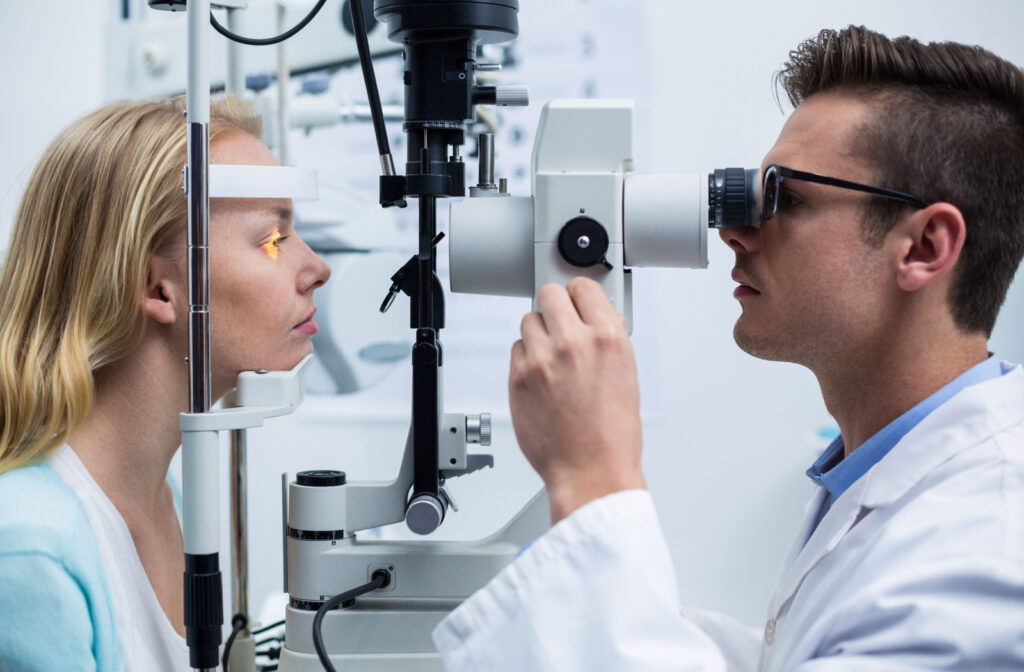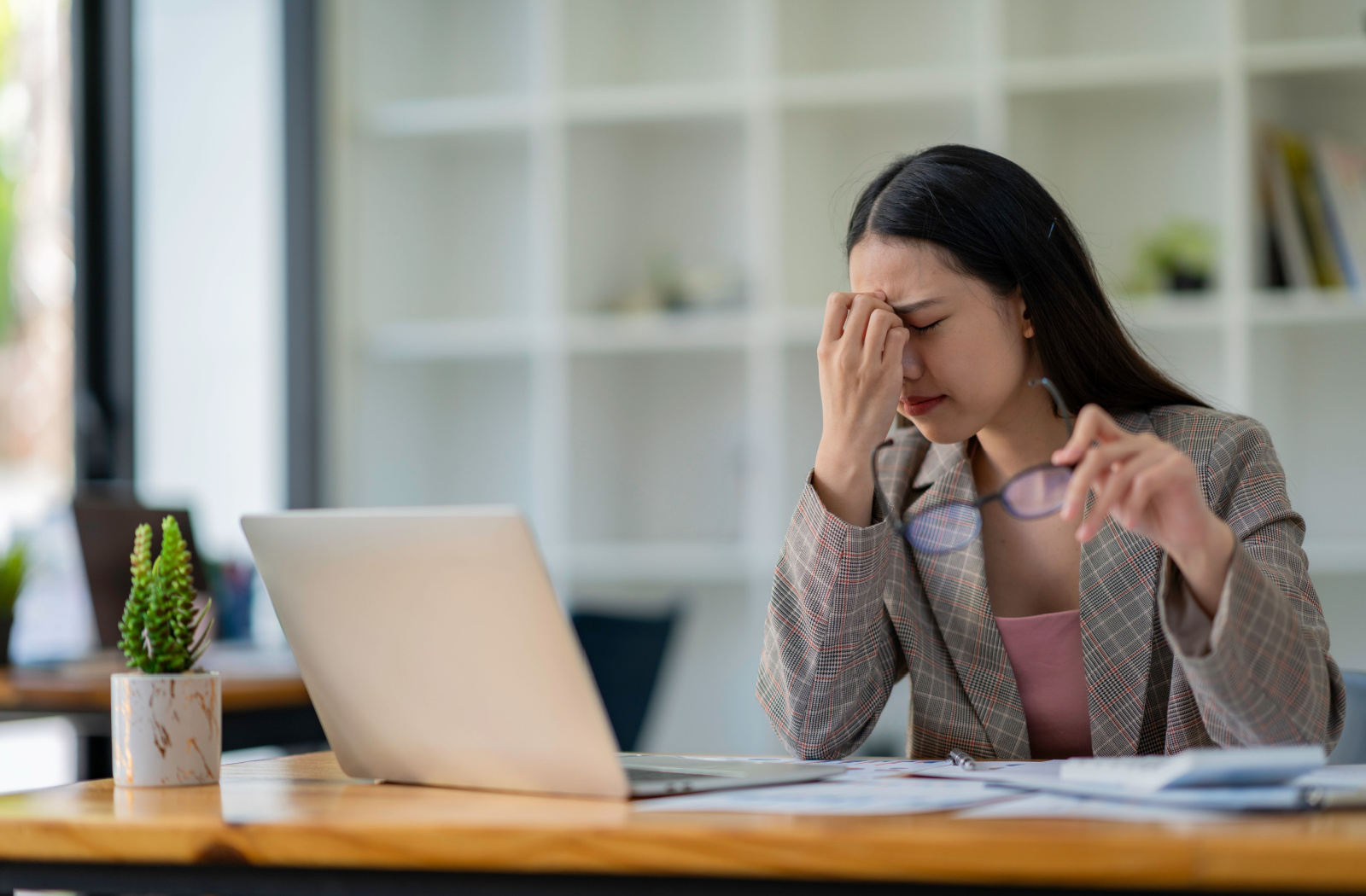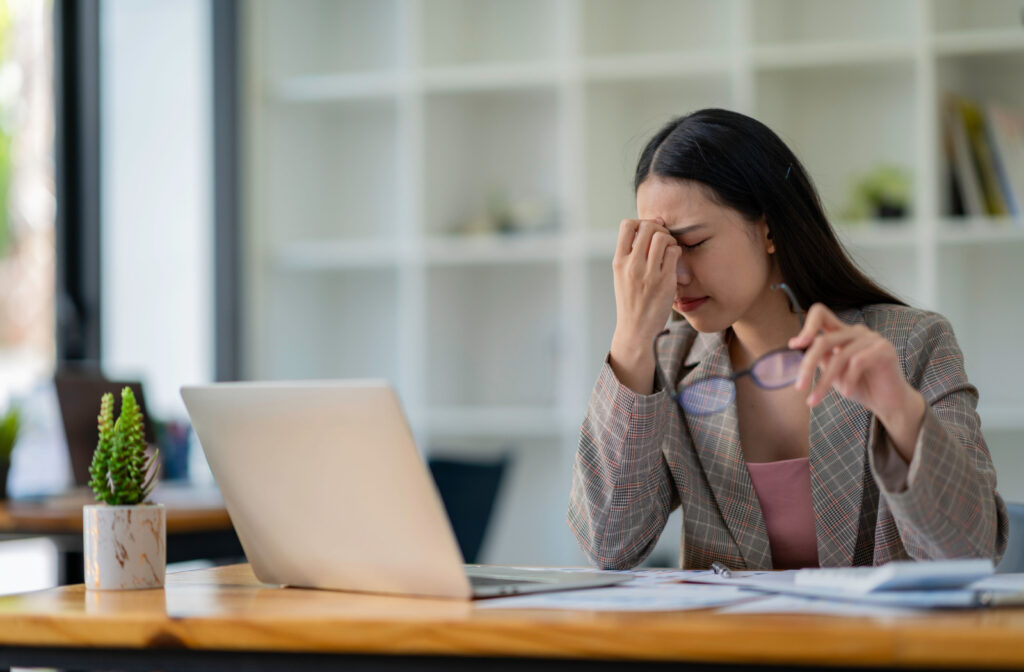Technology plays a significant role in our lives today. Around 80% of Americans spend over two hours every day on digital devices, leading to a common issue–digital eye strain. Although various factors can cause eye strain, technology is responsible for approximately 60% of reported cases.
How long should eye strain last before feeling relief?
While eye strain is different for everyone, it should go away minutes to hours after ceasing high-focus activities involving the eye.
Regular eye exams with your optometrist and following the treatment plan they recommend can help you find relief from eye strain.
What Is Eye Strain?
Eye strain happens when your eyes become sore and fatigued from focusing for a lengthy period. When using a computer or other high-concentration activity, your eyes must focus and refocus, which causes fatigue in the eyes—especially when done for extended periods without rest.
While technology use is a typical source of eye strain, other activities, such as reading and driving, can also cause the condition.
Although eye strain does not cause long-term harm, it may trigger several symptoms, including:
- Fuzzy vision
- Dual vision
- Redness
- Irritation of the eyes
- Dry eyes
- Headaches
- Back or neck aches
- Difficulty focusing
- Increased light sensitivity
The Muscle Responsible
Just like your arm muscle is activated when performing a bicep curl, your ciliary muscle, which is part of your eye’s focusing system, really gets to work when you’re focusing on something close up. This little ring-shaped muscle, which stretches out from your iris, changes the shape of your lens directly.
What Are The Causes Of Eye Strain?
Eye strain can occur subtly when focusing on an activity for an extended period without taking breaks. It’s typical to engage in close-up tasks each day, which can potentially cause discomfort to the eyes.
The causes of eye strain are varied. It can be caused by poor posture while engrossed in high-focus activities such as reading or using digital devices. But infrequent blinking or holding your device or book at an improper distance from your eyes can also contribute to eye strain.
Other activities that can lead to eye strain include:
- Reading
- Writing
- Driving
- Using screens on any digital device
- Spending extended periods in dim lighting
- Experiencing stress or fatigue
How To Prevent Eye Strain
Eye strain can take a toll on your day-to-day activities. Thankfully, there are several straightforward methods available to find relief that can be incorporated throughout your day.
20-20-20 Rule
Every 20 minutes, you should focus your attention away from the activity causing you eye strain. Focus on something that is at least 20 feet away for at least 20 seconds. This 20-20-20 rule is simple and effective at finding comfort.
If you work at a computer for a living or drive frequently, balance these activities with others that require different usage of your eyes. Taking a walk outside in natural lighting, for example, can do wonders for finding relief.
Adjusting Your Workstation
How far away your screen or book is positioned while working or reading can impact your eyes. Make sure that your device is at an appropriate distance and location. This should be approximately 20 inches away from your eyes.
Additionally, the lighting required for your eyes to properly focus is important. Poor lighting can be a cause of eye strain. Matching the lighting of your screen to the brightness of the room may help lessen the strain on your eyes.
Using Eye Drops
The average person blinks around 12 times per minute, however, this number dramatically reduces when staring at a digital screen or a book.
Blinking less frequently causes your eyes to become dry and irritated. Resolution can be found by reminding yourself to blink more often, but this is difficult for most people to remember to do, which leaves eye drops as a practical solution.
If you continue to experience discomfort after implementing these methods, contact your eye doctor for an assessment.

You Don’t Have To Struggle With Eye Strain
You don’t have to put up with eye strain—even in this highly focused digital world we live in. Following these preventative tips can help you see a decrease in the strain on your eyes within a couple of hours to a day, depending on how long you spend engaging in the high-focus activity.
If you’re still experiencing symptoms, don’t hesitate to talk to your eye doctor at Dr. Jennifer L. Shane & Associates and book an appointment. Remember, we are always ready to help you improve your vision!At Dr. Jennifer L. Shane & Associates, we’re all about using the latest optometric technology to give you a thorough eye exam. But what really sets us apart is how we care for our patients. We always aim to make your visit a top-notch eye care experience—every single time you drop by.



